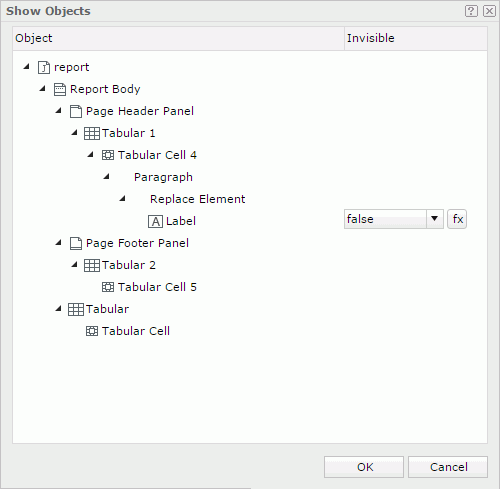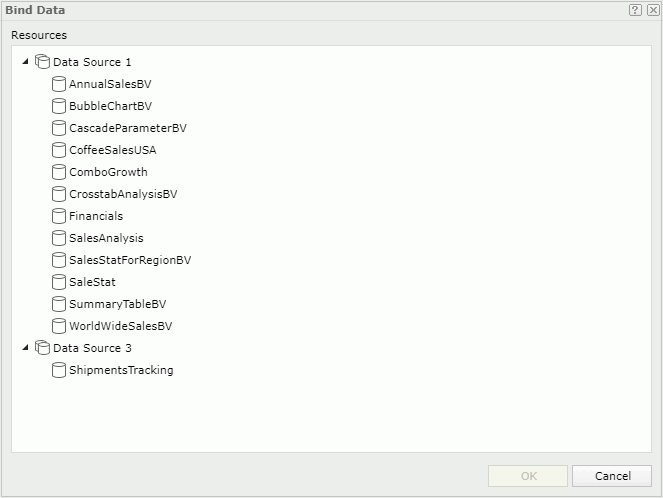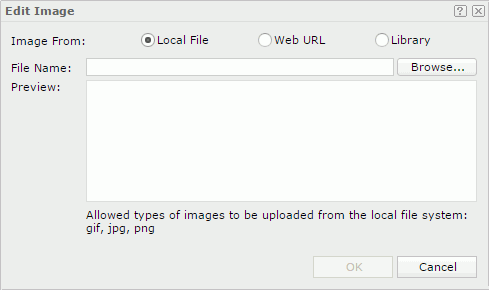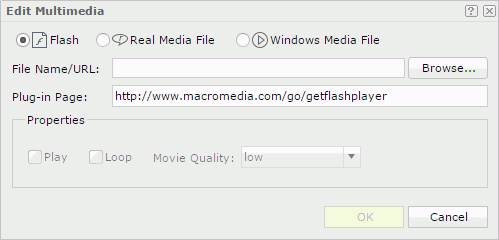 Previous Page Next Page
Previous Page Next Page
Resizing a component and its elements
Modifying component properties
This section introduces the general actions that you can perform on the report components.
When the Position property of a component is absolute, it can be moved to another place in the current container freely. To move a component, hover the mouse pointer on the component, when the icon  appear at the top right, drag the icon to the destination and then drop.
appear at the top right, drag the icon to the destination and then drop.
To resize a component, click anywhere in the component, then you will see it is surrounded by a rectangle with resizing handles. Point to a handle, when the mouse pointer turns to a double-headed arrow, you can drag the handle to resize the component.

To adjust the width of a column in a table, click anywhere in the column, then click the button  that appears on the column header to select the column. Point to the left or right boundary of the column, when the mouse pointer becomes a double-headed arrow, drag the handle to resize the column.
that appears on the column header to select the column. Point to the left or right boundary of the column, when the mouse pointer becomes a double-headed arrow, drag the handle to resize the column.

To adjust the row height in a table, click anywhere in the row, then click the button  that appears at the leftmost on the row to select the row. Point to the upper or lower boundary of a row, when the mouse pointer becomes a double-headed arrow, drag the handle to resize the row height. Then all the other rows of the same role will be resized too. For example, if a detail row is resized, all rows in the detail area will be resized. If a group row is resized, all rows of the group will be resized, while the other groups' rows keep unchanged.
that appears at the leftmost on the row to select the row. Point to the upper or lower boundary of a row, when the mouse pointer becomes a double-headed arrow, drag the handle to resize the row height. Then all the other rows of the same role will be resized too. For example, if a detail row is resized, all rows in the detail area will be resized. If a group row is resized, all rows of the group will be resized, while the other groups' rows keep unchanged.
To resize the column or row in a crosstab, drag the right or lower boundary. Then all the columns or rows of the same role will change too.
To adjust the panel height in a banded object, select the panel and drag the lower boundary of the panel until the panel is at the required height.
For a tabular, point to the boundary between two cells and the mouse pointer will become a double-headed arrow, you can then drag the boundary to adjust the size of the related cells.
To hide a component, right-click on the component, then click Hide on the shortcut menu.
To show the hidden components, click Menu > Edit > Unhide Components and then select the desired components to show from the drop-down list.
You can also set the Invisible property in the Inspector panel to show or hide a component. To do this, select the node that represents the component in the report structure tree in the Inspector panel, then set its Invisible property as required. If the parent of the component has no data source, you can click  in the value cell and select a formula from the value drop-down list, or select <Edit Expression> to create an expression with the Formula Editor to control whether or not to show the component.
in the value cell and select a formula from the value drop-down list, or select <Edit Expression> to create an expression with the Formula Editor to control whether or not to show the component.
For any component whose parent doesn't have a data source, for example, a label in the tabular cell of a web report, you can also use the Show Objects dialog to show or hide them. To do this:
 on the toolbar. The Show Objects dialog appears.
on the toolbar. The Show Objects dialog appears.

Using formulas to control showing or hiding components
You can use formulas to control whether the components whose parents have no data source will be shown or not in a web report. However, before doing this, you need to first bind a data source to the web report, then create dynamic formulas of Boolean type based on this data source and use these formulas to control the Invisible property of the required components. A return value of true will hide the component.
To use formulas to control which components to show in a web report, follow the steps below:

 on the toolbar to display the Show Objects dialog.
on the toolbar to display the Show Objects dialog. beside the Invisible property of the component which you want to control by formula and select the required formula from the drop-down list. Repeat this to select formulas for other components.
beside the Invisible property of the component which you want to control by formula and select the required formula from the drop-down list. Repeat this to select formulas for other components. on the upper right corner to show the report structure tree.
on the upper right corner to show the report structure tree. in the value cell of the Invisible property, then select the required formula from the drop-down list, or click <Create Formula> in the drop-down list and create a dynamic formula in the bound data source to control the property value.
in the value cell of the Invisible property, then select the required formula from the drop-down list, or click <Create Formula> in the drop-down list and create a dynamic formula in the bound data source to control the property value.Then whether the components will be shown or not will then be determined by the return value of the specified formulas.
If you set the Invisible property of a component to true using a formula, the object will not be listed in the Menu > Edit > Unhide Components drop-down list. You can show it only by using the Show Objects dialog. Meanwhile, once the Invisible property of a component in a web report is controlled by a formula, the data source bound to the web report cannot be changed unless you remove the relationship between the formula and the property.
For a web report created in JReport Designer, if it has been bound with a data source before being published to JReport Server, and some dynamic formulas have been created based on this data source:


To merge adjacent cells, select them one by one while holding the Ctrl key, then click Menu > Format > Merge or click  on the toolbar, and these cells will be merged into one cell.
on the toolbar, and these cells will be merged into one cell.
 on the toolbar to split the cell vertically or horizontally.
on the toolbar to split the cell vertically or horizontally.You can modify the component properties with either the corresponding properties dialog or the Inspector panel.
To edit the properties of a component in a report, right-click it and select Properties from the shortcut menu (for a table row you need to first click anywhere in the row and then click the button  that appears at its leftmost to select the row, then you can right-click on the row to get the Properties command on the shortcut menu). In the corresponding properties dialog, specify the settings as required. For detailed explanation about options in the properties dialogs, refer to the specific topics in Web Report Studio Dialogs.
that appears at its leftmost to select the row, then you can right-click on the row to get the Properties command on the shortcut menu). In the corresponding properties dialog, specify the settings as required. For detailed explanation about options in the properties dialogs, refer to the specific topics in Web Report Studio Dialogs.
If you want to format the properties of the report, click Menu > Edit > Report Body Properties, then in the Report Body Properties dialog, configure the properties as required.
The Inspector panel of Web Report Studio is for managing properties of the objects in a web report (to display the panel, click Menu > View > Inspector).
To edit the properties of an object with the Inspector panel, first select the object in the report, or click  on the upper right corner of the Inspector panel to show the report structure tree and then select it from the tree. All properties of the selected object are displayed in the Properties sheet which contains two columns: Name and Value. Each type of object has its own set of properties. Depending on the object type, the properties that a certain object holds may greatly differ from those of another. You can change how an object appears and behaves by editing its property values. For details about properties of each object, see Web Report Object Property Reference.
on the upper right corner of the Inspector panel to show the report structure tree and then select it from the tree. All properties of the selected object are displayed in the Properties sheet which contains two columns: Name and Value. Each type of object has its own set of properties. Depending on the object type, the properties that a certain object holds may greatly differ from those of another. You can change how an object appears and behaves by editing its property values. For details about properties of each object, see Web Report Object Property Reference.
When a report contains a lot of objects, you can make use of the search toolbar at the top of the report structure tree panel to easily locate an object in the tree.



Report templates in JReport use a flow layout model. That is, paragraphs and components in the report body can flow from one page to another, maintaining their sequence, and the Position property controls whether a component is to be part of the flow, or separate from it. Besides the report body, tabular cells themselves in JReport can also act as flow layout containers.
In a flow layout model, objects are positioned relative to one another or absolutely. The Position property controls the position of components in the flow layout container. Components placed in other areas such as table cells, are not affected by the Position property.
The Position property can be one of the following values:
To change the position property of a component, click on the component to select it, then:
Note: The position of an object in a banded object can only be Absolute.
A component can be removed from the report if it is no longer required. To delete a component, right-click on the component and select Delete from the shortcut menu. If a message prompts asking for your confirmation, click Yes to confirm the removal.
You can also remove a KPI chart from its KPI by right-clicking the KPI and then selecting Remove KPI Chart from the shortcut menu.